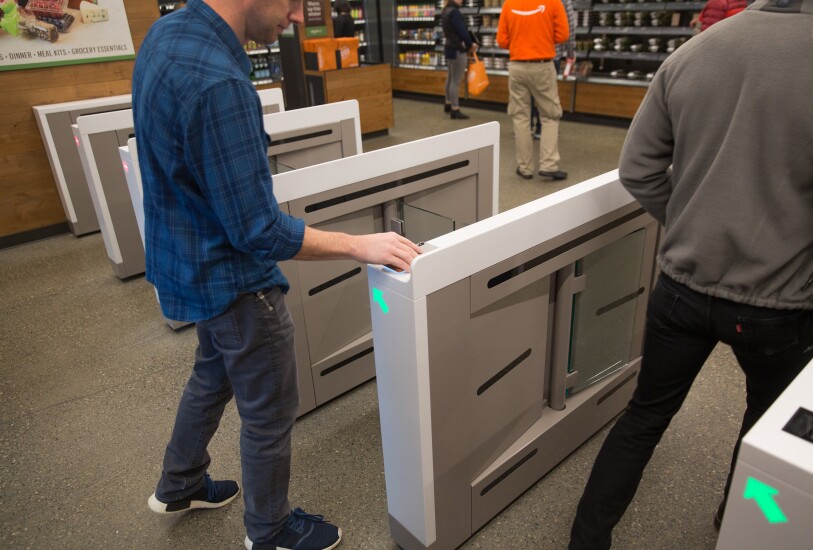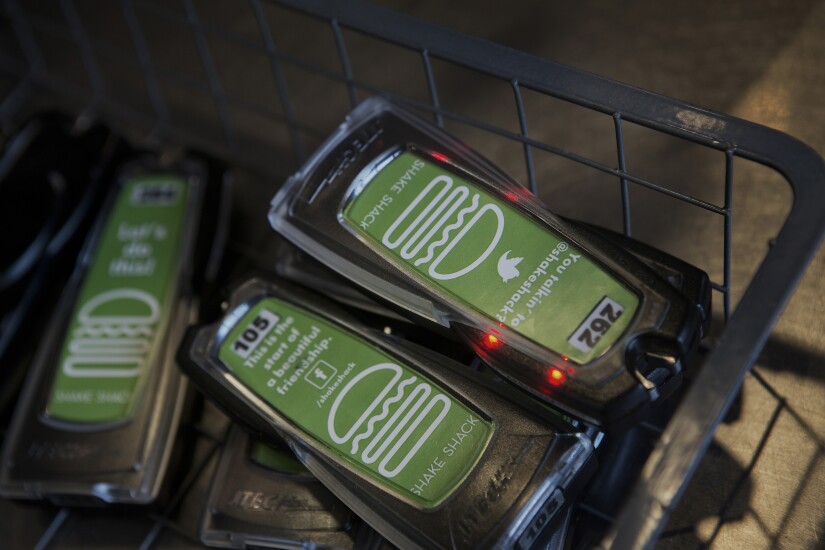
These brands are using mobile technology to either do away with cash or to completely reinvent the flow of traffic through their stores. Through the use of mobile devices, these companies are greatly expanding the data they collect on shoppers and streamlining the process of getting products into buyers' hands.
This listicle is compiled from reporting by PaymentsSource writers including John Adams, David Heun and Nick Holland. Click the links in each item to read more.

Disney imagines a world without cash
The lodge is separate from the Animal Kingdom theme park, one of many resorts Disney operates in Florida. As with other Disney hotels, Animal Kingdom Lodge guests have free bus access to the theme parks, meaning they never have to leave the Disney ecosystem for the duration of their stay.
Thus, it's clear that while cash is still accepted at the rest of Disney's properties, the company will be watching closely to see whether Animal Kingdom Lodge guests build habits that follow them throughout their vacation.
"Cash represents a larger problem for amusement parks than for many other merchant types," said Rick Oglesby, founder and president of AZ Payments Group. "The nature of the amusement park, having huge crowds, wild rides and many opportunities to get soaking wet, makes it undesirable to carry valuables of any type, including cash."
For Disney, a cashless property is not as radical a departure as it would be for a restaurant or a shopping mall. Disney has long designed its theme parks to exist as worlds unto themselves, issuing its own "currency" to use as money or as a souvenir.
All of this goes back to Walt Disney's original vision of

Amazon Go's unique barrier to entry
By placing this gate at the front of the store and requiring customers to scan in, Amazon does more than open a digital shopping cart for its guests. It actually flips the script on store loyalty — rather than ask rushed shoppers to sign up for a store loyalty card or credit account during checkout (as way too many stores do today), Amazon makes sure it identifies each customer and his or her payment method at the very beginning.
This not only has obvious benefits for risk management and streamlining payments; it also gives the retailer insight into the time shoppers showed up at the store only to leave empty-handed. It's also a chance to lock in a preferred payment method such as the Amazon cobranded credit card or stored-value account without the risk of shoppers changing their mind during checkout.

Shake Shack doesn't want customers to dine in anonymity
Suppressing cash is simply the first step. Through the Astor Place location's use of kiosks and a text messaging system that replaces the pagers it uses at other locations to let patrons know an order is ready, Shake Shack can greatly deepen its relationship with each customer while also slashing its own operational costs.
The typical Shake Shack ordering process involves standing in one of two lines to order (one for food and drink, and a faster line for only drinks), paying a cashier, then waiting again for the pager to buzz when the order is ready. The system results in such long lines that Shake Shack provides a "
Almost all of this process is removed in the company's new model, which relies on kiosks or a mobile device and — crucially — collects the customer's phone number as part of the ordering process so that it can send a text alert when the food is ready.
"Beyond eliminating cash it's about eliminating the point of sale. That's a game changer," said Richard Crone, a payments consultant and researcher.
It's clear that this purely digital system opens new possibilities that might have been just out of reach in a system that still allows cash.
Shake Shack already has an order-ahead app, which should of course be compatible with the new location. The app lets users select a location and pickup time, and remembers customers by either creating a Shake Shack account or asking them to link a Facebook or Google account. In this model, the app handles the payment and also doubles as the buzzer — but one look at the Shack Cam is enough to show that many customers still pay the old fashioned way.
So what can be done about the customers who won't pay through the app, but who Shake Shack still wants to remember? Though the Payment Card Industry data security standards limit what companies can do with the card data they collect, there are some examples already of how much can be done when customers pay by card.
Square is a prime example. The company can identify consumers by their card, regardless of which merchant they shop at, sends a digital receipt to the email address it already has on file. In 2014, Square introduced interactive receipts under a service called Square Feedback, which allows merchants to request feedback on the sale and thus develop a relationship with the customer.
Whether Shake Shack is planning something similar is unclear. The company has shared
"Cashless" also isn’t the best way to describe this experiment, said Rick Oglesby, president of AZ Payments Group. "Cashless implies the removal of cash as a payment option, and nothing more. This concept is a very different shopping experience from start to finish, one that makes cash irrelevant. We’ll see a lot more of these concept stores being tested to evaluate consumer preferences, find the right models, and then work out the kinks."

Square lowers the bitcoin barrier
So it may seem odd at first that Square is using this app as a testbed for
When Square launched
Five years on, things are entirely different, with numerous P-to-P vendors carving out niches and establishing unique value propositions. Zelle has the backing of large banks, Venmo has the mindshare of millennials, and PayPal has the longest history. Further, P-to-P usage is unlikely to be exclusive — according to Apptopia, 84% of Cash app users are likely to have already installed the Venmo app. Square Cash is likely to be a second choice for sending funds to a recipient who doesn't want to download a dedicated P-to-P app.
Given the somewhat vanilla appeal of Square Cash and its self-imposed quarantine from Square’s other products, Square has the opportunity to experiment within the Cash platform without having any direct repercussions for its more mainstream products.
The bitcoin pilot fills this role perfectly.
"Bitcoin, for us, is not stopping at buying and selling," CEO
Despite the significant interest in the blockchain technology that enables bitcoin, cryptocurrencies are still viewed by the general public as vehicles for

Before there was Amazon or Square, there was Apple
Apple stores are well-known for a design that is well-lit and welcoming, and part of creating that atmosphere is the idea that any part of the store can be used for checkout. If a customer is admiring a new iPhone or Mac, all they have to do is catch an employee's attention to begin the process of purchasing the product.
The process is heavily influenced by the use of mobile technology. Though the retailer accepts its own Apple Pay wallet, it doesn't exclusively require it. Google Pay and plastic cards work just as well on employees' handheld point of sale devices.
Even though Apple isn't using Square's mobile card readers, Square CEO Jack Dorsey has cited Apple's model as good marketing for his own product. "All the larger retailers and medium-sized retailers want to replicate what they see in the Apple store, where they can actually bring the point of sale to the decision, instead of making people queue up behind the cash register," Dorsey said in an

A Freshii franchisee asks mobile customers to split the bill before they order
"I created a card that I would put on every order ticket that said 'skip the line and order online,' " said Grossman, who has worked for
The rudimentary email pre-orders at Grossman's stores were helpful, but limiting in that it still focused on a one-on-one interaction with the customer. Grossman has since implemented technology that allows multiple customers to submit a single order, such as when buying a takeout lunch with coworkers.
Grossman is an early adopter of Ritual's order-ahead app, and in two years adoption has grown to 10% of the business at his franchises. Ritual has elements of social payment apps like Venmo, at least from the consumer's perspective. The users pay individually through the app, but the merchant sees it as a single order.
"It's kind of like Uber — you order on the phone with a card that you have on file that collects the payment and remits it to the merchant after the fact," said Ray Reddy, a co-founder and CEO of Ritual.
The app tracks ordering and user tendencies and creates marketing programs, after-hours dinner and corporate programs to entice employers to adopt the service for their office. The merchants pay a fee for consumers that Ritual onboards; the consumers don't pay a fee.
"It's more than ordering ahead, it's like an in-store order," Reddy said. "It can be awkward and cumbersome for one person to go around an office and pick up money for an order."

Starbucks sees the limits of its mobile success
The company reported in the fourth quarter that 30% of total tender is now via mobile payment, a figure that has not increased since
Kevin Johnson, president and chief executive of Starbucks, attributed some of the weak financial quarter performance to softness in visits by occasional non-Starbucks rewards customers. The loyalty program itself is still going strong — it added over 1.4 million active rewards members in the U.S. during the quarter, up 11% year over year, and now has a total of 14.2 million active members.
Nonetheless, the need to transition people to the Starbucks app — and, in doing so, transition them to digital payments — is mission critical for expediting in-store interactions and capturing consumer data.
Johnson highlighted several initiatives that either directly or indirectly provide an on-ramp for enrollment to the digital Starbucks ecosystem. These include mobile order and pay for non-rewards customers starting in March. At the same time, it is launching a marketing initiative to sign up customers for special offers outside of Starbucks Rewards.
“With only 14 million of the 75 million or so unique customers, who visit us each month signed up for rewards, we have a tremendous opportunity to leverage our new digital technologies to initiate and advance additional direct digital relationships,” Johnson said.





